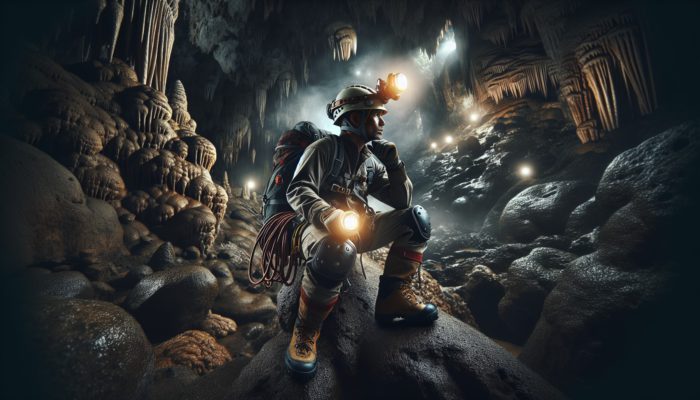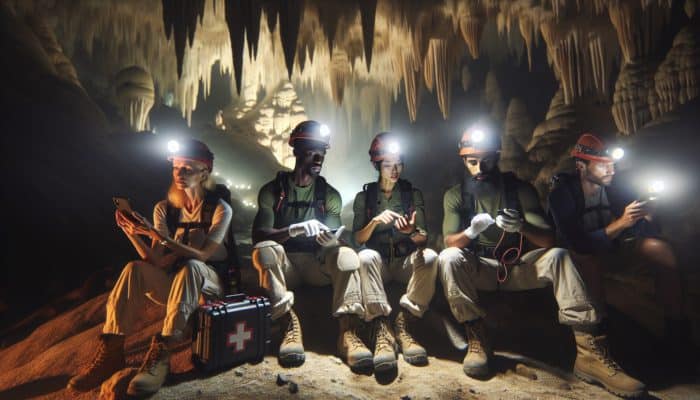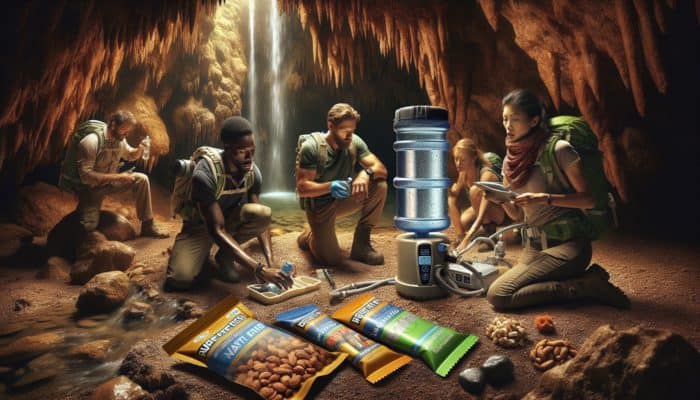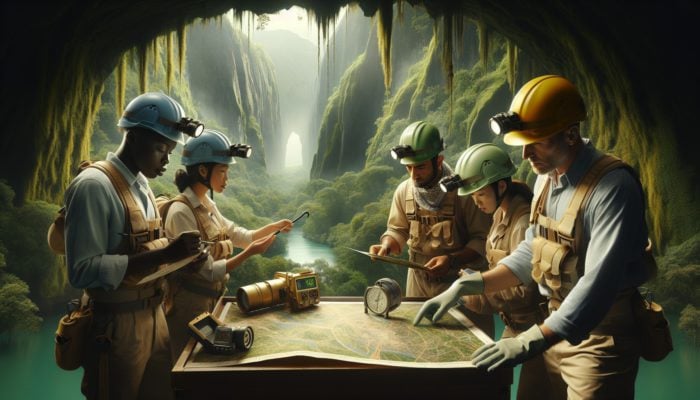Essential Preparations for Safe Cave Exploration
What Equipment Is Indispensable for Cave Survival?

Survival in Caves: Choosing the appropriate equipment is vital for ensuring both safety and success during your cave exploration. The right gear not only safeguards you but also enhances your ability to navigate through the often unpredictable and challenging environments found in caves. Essential items should include those that focus on both lighting and protection, ensuring you are well-equipped to manage various conditions. The key components of your caving kit should comprise:
- Helmet: A durable helmet to shield against falling rocks and potential impacts.
- Headlamp: A dependable, bright light source with spare batteries to ensure visibility.
- Sturdy Footwear: Robust, waterproof boots with excellent traction for navigating slippery and uneven surfaces.
- Gloves: Protective gloves to prevent cuts and scrapes while climbing or crawling.
- Rope and Harness: Essential for ascending vertical sections or crossing chasms safely.
- First Aid Kit: A comprehensive kit to address any injuries that may occur during your expedition.
- Map and Compass: Navigational tools that assist in finding your way through complex cave systems.
- Emergency Whistle: A loud, compact whistle can be invaluable for signalling rescue teams if necessary.
Equipping yourself with this essential gear can greatly enhance your safety and comfort, leading to a more rewarding and successful cave exploration experience. It’s important to remember that the specific conditions of the cave could necessitate additional specialised equipment, so conducting thorough research before your expedition is crucial.
How to Physically Prepare for Cave Expeditions?
Cave exploration demands a high level of physical fitness due to the unpredictable and often strenuous nature of the environment. Engaging in a well-rounded fitness regimen is essential, as it ensures your body can manage the rigours of climbing, crawling, and navigating through tight spaces. Effective training should focus on developing strength, endurance, and flexibility, allowing you to adapt seamlessly to the physical challenges presented by caves.
Begin your preparation with strength training exercises that target the core, legs, and upper body. Activities such as squats, push-ups, and planks build the necessary muscle groups for climbing and manoeuvring through rocky terrains. Incorporating cardiovascular workouts like running, cycling, or swimming will boost your overall stamina, which is vital for hours of exploration. Additionally, flexibility exercises, including yoga or stretching, enhance your ability to navigate through tight spaces without risking injury.
Moreover, consider incorporating specific cave-oriented training activities, such as bouldering or indoor rock climbing, to simulate the conditions you may face while caving. Engaging in these activities not only enhances your physical capabilities but also familiarises you with the movements essential for successful cave exploration. Ultimately, a balanced workout routine will adequately prepare your body for the demanding nature of caves, ensuring a safer and more enjoyable experience.
Mental Strategies for Overcoming Underground Challenges
Mental preparedness is just as crucial as physical fitness when gearing up for cave exploration. The underground environment can be disorienting and stressful, making it essential to equip yourself with effective mental strategies to tackle various challenges. Developing mental resilience enhances your ability to remain calm and composed, even when faced with unexpected situations.
Utilising visualization techniques can greatly improve your mental preparedness. Before entering a cave, take time to visualise yourself successfully navigating through the tunnels, overcoming obstacles, and emerging safely. This mental rehearsal can instill confidence and alleviate anxiety. Additionally, practising mindfulness and relaxation techniques can help manage stress and maintain focus during your expedition. Techniques such as deep breathing or meditation can ground you when confronted with overwhelming darkness or confined spaces.
Furthermore, developing a contingency plan for potential challenges will build your mental fortitude. Familiarise yourself with emergency procedures and rehearse how to respond to various scenarios, such as getting lost or dealing with a cave-in. This preparedness empowers you to handle crises calmly and effectively, reinforcing your overall mental strength as you face the underground challenges of cave exploration.
Implementing Safety Protocols and Emergency Procedures

Comprehending safety protocols and emergency procedures is paramount for cave exploration. Safety should always be your foremost priority, as the nature of caves can present numerous hazards. Before embarking on your expedition, ensure you are familiar with essential protocols, and confirm that all team members are aware of the procedures.
Start by learning basic first aid and emergency communication techniques. Knowing how to administer first aid can save lives in the event of an injury. Equip yourself with a first aid manual or enrol in a course to sharpen your skills. Additionally, establish clear communication methods, such as hand signals or whistles, to maintain contact with team members in the dark or when separated.
Emergency procedures should also encompass an understanding of cave rescue techniques. Familiarise yourself with the basic principles of cave rescue, including how to signal for help and the correct use of equipment. Real-world scenarios highlight the importance of these preparations; for instance, if a team member becomes injured or lost, understanding how to initiate a rescue operation can be critical. Establishing a buddy system and regularly checking on each other throughout the exploration adds an extra layer of safety. By adhering to these protocols, you can significantly enhance your safety and preparedness for cave exploration.
Insights from Experts on Cave Survival Techniques
What Insights Do Experts Offer About Cave Navigation?
Successfully navigating caves necessitates a comprehensive understanding of mapping and route-finding, as the intricate networks can be overwhelming. Experts underscore the significance of staying oriented and using natural landmarks to guide your path through complex cave systems. Mastering cave navigation involves not just relying on tools but also comprehending the cave’s structure and your surroundings.
Begin by studying cave maps before your entry. Familiarise yourself with the cave’s layout, noting key features such as entrances, exits, and notable formations. During your exploration, use a compass to help maintain your direction, particularly as many caves can disorient even the most seasoned explorers. Pay close attention to natural landmarks, such as distinctive rock formations or streams, to help retain your sense of direction.
Effective navigation also requires establishing a systematic approach to route-finding. Implement a strategy where you document your journey by marking points of interest or taking notes. Regularly verify your position against the map to ensure you remain on course. Should you encounter junctions or forks in the path, take a moment to evaluate your options and choose the most suitable route based on your prior knowledge and the cave’s features. Developing these navigation skills will enhance your confidence and efficiency as you explore, ensuring you can safely find your way in even the most complex cave environments.
How to Efficiently Manage Resources in Caves?

Resource management is critical in caves where supplies are limited, making efficient planning essential for survival. Strategies should focus on rationing food and water, conserving energy, and ensuring that your resources last throughout your exploration. Proper management not only sustains you during your time underground but also reduces the risk of running out of essential supplies.
Start by carefully assessing your needs before entering the cave. Determine how much food and water you will require, considering the duration of your stay and the intensity of your activities. It is advisable to pack lightweight, high-energy snacks like nuts or energy bars that are easy to carry and consume. Additionally, always bring extra water or a filtration system to ensure you can safely replenish your supply if you find a water source inside the cave.
Energy conservation is another crucial aspect of resource management. Plan your route to minimise unnecessary movements, and take breaks to avoid over-exertion. Avoid strenuous activities during the hottest parts of the day to allow your body to conserve energy and reduce your need for food and water. By implementing these strategies, you can effectively manage your resources, ensuring a successful and sustainable cave exploration experience.
Expert Recommendations for Handling Cave Emergencies
Emergencies in caves can pose life-threatening situations, making it essential to have a solid plan in place. Experts recommend maintaining composure, following established safety protocols, and signalling for help if needed. Understanding how to effectively respond to emergencies not only increases your chances of survival but also minimizes panic during critical situations.
First and foremost, always ensure you have a clear emergency plan before entering the cave. Confirm that all team members are familiar with the procedures and know their roles during a crisis. For instance, if someone sustains an injury, designate a person to administer first aid while another communicates with outside support or initiates a rescue. Prior preparation can significantly enhance your response time and overall effectiveness.
Real-world examples illustrate the importance of these strategies. In one notable case, a caving expedition was interrupted when a member fell and suffered a leg fracture. The team immediately implemented their emergency plan, utilising their first aid training while maintaining communication with an external support team. Their preparedness and calm approach allowed them to navigate the emergency efficiently, ultimately ensuring the safety of the injured member.
Additionally, always carry signalling devices such as whistles or mirrors to attract attention if you become separated from your group or find yourself in distress. Practising these emergency protocols as a team regularly can build confidence and preparedness, making a significant difference in a crisis.
What Are the Fundamental Survival Skills for Caves?
Mastering Essential Cave Survival Techniques
Basic survival skills in caves encompass critical abilities such as fire-making, shelter-building, and water purification. Mastering these techniques is essential for prolonged stays underground, as they can greatly increase your chances of survival during emergencies or unexpected delays.
Fire-making stands out as one of the most vital survival skills in a cave setting. A well-maintained fire not only provides warmth but also serves as a signal for rescue and a source of light. Learning to start a fire in damp conditions is crucial, as caves may lack dry materials. Carry waterproof fire starters and practice building fires in various conditions outside of the cave environment to build confidence and skill.
Shelter-building is another essential skill, particularly in caves with extreme temperatures or drafts. Knowing how to create a makeshift shelter using available materials enhances safety and comfort. Look for natural formations that can provide protection from the elements and use gear such as tarps or blankets to create an insulated space.
Water purification is equally important for survival. While caves may offer water sources, it’s vital to ensure they are safe to drink. Techniques include using filtration systems or boiling water over a fire. Familiarise yourself with various methods of purifying water and carry portable purification devices, as these can be lifesavers during extended stays underground. Mastering these core survival skills equips you to handle a range of scenarios, enhancing your overall preparedness for cave exploration.
How to Locate and Purify Water in Caves?
Finding and purifying water is essential for survival in caves, where access to fresh water may be limited. Understanding how to identify potential water sources and purification techniques can significantly impact your ability to sustain yourself during an expedition.
Caves often contain water sources, such as streams, puddles, or dripping water from stalactites. Look for signs of moisture on the walls or floor, and listen for the sound of flowing water. When locating these sources, ensure you choose areas that appear clean and free from contamination, as water in caves can be affected by wildlife or mineral deposits.
Once you’ve identified a water source, purification is essential to eliminate harmful pathogens. The most effective methods include boiling water and using filtration devices. Boiling is straightforward; simply heat the water to a rolling boil for at least one minute to kill bacteria and viruses. If you carry a portable water filter, ensure it meets the necessary standards for purification. These filters typically utilize activated carbon or ceramic to remove impurities and enhance the taste.
If boiling or filtration isn’t feasible, chemical purification options, such as iodine tablets, can provide a temporary solution. However, be aware that these methods require time to work, so always plan your water needs in advance. By mastering the techniques to locate and purify water, you increase your chances of staying hydrated and healthy throughout your cave exploration.
Navigating Through Cave Systems Effectively
Successfully navigating through cave systems involves a combination of understanding cave maps, using compasses, and having a basic knowledge of cave geology. Mastering these skills not only improves your efficiency but also helps prevent disorientation while exploring complex cave networks.
Start by examining cave maps ahead of your expedition. Familiarise yourself with the layout, including key landmarks, potential hazards, and the locations of entrances and exits. Understanding how to read these maps is crucial for maintaining your bearings as you navigate.
Effectively using a compass is another critical skill for cave navigation. In a labyrinth of tunnels, relying solely on visual cues can lead to confusion. A compass helps you maintain your intended direction, especially in areas where traditional navigation methods may fail. Always double-check your bearings and ensure you understand how to use the compass in conjunction with the map.
Additionally, possessing a foundational knowledge of cave geology can aid in navigation. Recognising different rock formations and types can guide you through a cave by indicating the likelihood of finding certain paths or hazards. Understanding how caves form and the characteristics of their geology allows you to anticipate the structure and layout of the cave, enabling more informed navigation. By mastering these navigation techniques, you can confidently explore cave systems and reduce the risk of becoming lost.
Managing Psychological Challenges During Cave Exploration
Coping with feelings of isolation and darkness is essential during cave exploration, as the psychological challenges can significantly impact your overall experience. Understanding how to manage these emotions is crucial for maintaining mental well-being throughout your expedition.
One effective strategy for managing psychological challenges is to establish a routine. Creating a structured schedule for activities such as meals, rest, and exploration provides a sense of normalcy in the often disorienting environment of a cave. Keeping your mind engaged through planned tasks helps combat feelings of helplessness or panic.
Remaining mentally active is equally important. Engage in problem-solving activities, such as mapping out new routes or discussing your next steps with fellow explorers. Participating in group activities fosters connection and support, thereby reducing feelings of isolation. Additionally, creativity can serve as a powerful tool for maintaining mental health; consider bringing along a journal or sketchbook to document your experiences.
Utilising light as a psychological aid can also combat feelings of claustrophobia and fear. Carrying multiple light sources not only ensures visibility but also allows you to illuminate your surroundings, making the environment feel less oppressive. By maintaining a routine, engaging with your environment, and using light effectively, you can significantly enhance your mental resilience and overall experience during cave exploration.
Comprehending Cave Environments and Hazards
What Are the Common Hazards Found in Caves?
Caves present a variety of hazards, such as rock falls, flooding, and poor air quality. Awareness and preparedness are paramount for mitigating these risks and ensuring a safe exploration experience. Understanding the specific dangers associated with cave environments can help you develop effective strategies for safe navigation.
One of the most significant hazards is the risk of rock falls. Caves can have unstable ceilings or loose rocks, particularly in areas where water has eroded the structure. Always stay alert to your surroundings and avoid areas with visible cracks or loose material. Wearing a helmet provides an additional layer of protection against potential falls.
Flooding poses another serious risk, especially in caves with water sources. Heavy rainfall or rapid snowmelt can lead to sudden increases in water levels, creating hazardous conditions. Before entering a cave, check the weather forecast, and avoid exploring during or immediately after heavy rains. Familiarise yourself with the cave’s topography to identify potential flooding zones, and keep a close watch on water levels during your exploration.
Poor air quality is also a concern within caves. Certain areas may have low oxygen levels or high concentrations of harmful gases like carbon dioxide. Always be attuned to your physical sensations while inside a cave; dizziness, headaches, or difficulty breathing can indicate poor air quality. Carrying a portable air quality monitor can help you assess the environment, ensuring your safety as you explore. By staying vigilant about these common hazards, you can significantly reduce risks and enjoy a safer cave exploration experience.
How to Adjust to Varying Cave Conditions?
Caves can differ greatly in temperature, humidity, and terrain, necessitating adaptability to ensure a successful exploration. Each cave environment presents unique challenges that require a thoughtful approach to navigation, clothing, and equipment.
When exploring caves with fluctuating temperatures, dressing in layers is essential. Caves often maintain cooler temperatures than the outside environment, and the humidity can exacerbate this sensation. Wearing moisture-wicking base layers helps regulate body temperature, while insulated outer layers provide necessary warmth. Avoid cotton fabrics, as they retain moisture and can lead to hypothermia in cold conditions.
Managing moisture is equally critical in cave environments. Caves can be damp and slippery, making it essential to wear waterproof boots with good grip. Staying dry helps maintain your body temperature and energy levels. Carrying extra gear, such as dry bags, can protect your belongings from moisture damage, ensuring your equipment remains functional throughout your exploration.
Understanding the different types of cave formations can also aid in navigation. Familiarise yourself with common features such as stalactites, stalagmites, and flowstones to better orient yourself within the cave. Recognising how these formations interact with the environment can provide insights into the cave’s history and assist you in navigating effectively. By adapting your approach to the specific conditions of each cave, you can enhance your overall experience and safety during your exploration.
The Significance of Knowledge in Cave Geology
Understanding cave geology is critical for predicting cave behaviour and identifying safe routes. Familiarity with rock types, formations, and the geological processes that shape caves can be lifesaving in complex environments.
Caves are formed through various geological processes, including erosion, dissolution, and sedimentation. Familiarising yourself with the rock types found in a cave can help you anticipate the formations and potential hazards you may encounter. For example, limestone caves tend to have smooth, polished surfaces, while volcanic caves may feature rough, jagged walls. Understanding these characteristics can inform your navigation strategies.
Additionally, being aware of how geological processes impact cave conditions can enhance your safety. Different rock types can affect stability; for instance, limestone may erode more easily than granite, leading to potential rock falls. Recognising signs of instability, such as cracks or loose debris, allows you to avoid hazardous areas.
Knowledge of cave geology also enhances your appreciation of cave ecosystems. Many caves host unique flora and fauna adapted to the specific conditions present. Recognising these biological indicators can help you better appreciate the environment and contribute to responsible exploration practices. By enhancing your understanding of cave geology, you improve your ability to navigate safely and appreciate the intricate beauty of these underground worlds.
Essential Safety Equipment for Successful Cave Exploration
Helmets, headlamps, and appropriate footwear are crucial for ensuring safety during cave exploration. These items form the foundation of your safety equipment, allowing you to navigate effectively while protecting yourself from potential hazards.
A sturdy helmet is indispensable in cave exploration. It protects your head from falling rocks and impacts with low ceilings. When selecting a helmet, opt for one specifically designed for caving, as these typically include features such as adjustable straps and ventilation for enhanced comfort.
A reliable headlamp is another critical piece of equipment. It provides hands-free lighting, which is essential for navigating dark passages effectively. Look for headlamps with adjustable brightness levels and long battery life, ensuring you have adequate illumination throughout your exploration. Always pack extra batteries to avoid being left in the dark.
Proper footwear is essential for maintaining stability and traction in slippery, uneven cave environments. Choose durable, waterproof boots designed for caving, featuring non-slip soles to prevent falls. Additionally, consider adding extra items, such as gaiters, to protect against mud and moisture, thereby enhancing comfort and safety throughout your expedition.
Beyond these essentials, consider carrying additional safety equipment tailored to the cave’s complexity. Ropes and harnesses may be necessary for vertical sections, while first aid kits, emergency whistles, and portable air quality monitors can significantly enhance your safety and preparedness. By investing in quality safety equipment, you ensure a secure and enjoyable cave exploration experience.
Research-Backed Benefits of Cave Survival Skills
What Psychological Advantages Are Associated with Cave Survival?
Surviving in caves can significantly enhance self-confidence and resilience, offering profound psychological benefits. Engaging in challenging experiences, such as cave exploration, fosters personal growth and contributes to stress relief.
The act of overcoming the physical and mental challenges associated with cave exploration can substantially enhance your self-efficacy. Successfully navigating dark, confined spaces and facing the uncertainties inherent in cave environments fosters a sense of accomplishment that translates into increased confidence in other areas of life. This newfound self-assurance can empower you to tackle future challenges and seek out new experiences.
Research indicates that engaging in adventurous activities, such as caving, triggers the release of endorphins, which promote feelings of happiness and well-being. The adrenaline rush of navigating caves can also serve as a natural stress reliever, providing a welcome escape from the pressures of daily life.
Moreover, the camaraderie built during shared cave experiences strengthens social bonds. Collaborating as a team to navigate challenges fosters trust and collaboration, enhancing your sense of belonging. The psychological benefits of cave survival extend beyond the experience itself, contributing to overall mental well-being and personal development.
Physical Health Benefits of Cave Exploration Activities
Regular cave exploration can enhance physical fitness and cardiovascular health, making it an excellent activity for maintaining overall health. The physical demands of caving contribute to various health benefits, bolstering both strength and endurance.
Cave exploration involves a range of physical activities, including climbing, crawling, and navigating uneven terrain. These activities engage multiple muscle groups, improving overall strength and promoting muscle toning. Regular participation in such activities helps maintain a healthy body composition, reducing the risk of obesity and related health issues.
Additionally, the cardiovascular demands of cave exploration contribute to improved heart health. Engaging in vigorous activities within the cave environment elevates your heart rate, promoting better cardiovascular fitness. Over time, regular exploration can lead to improved endurance and increased aerobic capacity, enabling you to engage in other physical activities with greater ease.
Caving also offers opportunities to connect with nature, which has been linked to improved mental health and reduced stress levels. The immersive experience of being underground, surrounded by unique geological formations, can provide a sense of tranquillity and connection to the natural world. By embracing the physical health advantages of cave exploration, you not only enhance your fitness but also cultivate a deeper appreciation for the environment.
How Does Cave Survival Enhance Problem-Solving Skills?
Cave survival often requires quick thinking and innovative solutions, making it an excellent training ground for honing problem-solving skills. The unpredictable nature of cave exploration fosters cognitive flexibility and enhances your ability to adapt to changing circumstances.
In cave environments, you may encounter unexpected challenges, such as navigating tight passages, managing limited resources, or responding to emergencies. These situations demand rapid assessment and effective decision-making, sharpening your problem-solving abilities. Practising these skills in real-world scenarios enhances your capacity to think critically and creatively under pressure.
Research suggests that engaging in challenging experiences fosters cognitive flexibility, enabling individuals to approach problems from different angles and develop novel solutions. The immersive nature of cave survival encourages you to think outside the box, as traditional methods may not always apply in the unique environment of a cave.
Furthermore, collaboration with fellow explorers enhances problem-solving opportunities. Working together to overcome obstacles builds teamwork skills and encourages the sharing of diverse perspectives. This collaborative approach to problem-solving not only enhances your ability to navigate cave challenges but also translates to improved skills in other areas of life.
How Can Cave Survival Foster Strong Social Bonds?
Surviving in caves often necessitates teamwork, which enhances social connections that can last a lifetime. The shared experience of navigating challenges together fosters trust and builds strong relationships among participants.
Engaging in cave exploration with friends or family strengthens existing bonds by encouraging reliance on one another for safety and support. The shared adrenaline rush of facing challenges together fosters camaraderie, contributing to a deeper connection among team members. Collaborative problem-solving during cave navigation creates lasting memories and reinforces the value of teamwork.
Research indicates that shared challenging experiences can strengthen relationships and build trust among individuals. The reliance on one another to overcome obstacles enhances communication skills and fosters a supportive environment, creating a sense of belonging and community.
Furthermore, the unique nature of cave exploration offers a distinct context for personal sharing and emotional connection. Discussing fears, experiences, and triumphs in such an intimate setting nurtures deeper conversations that can enrich friendships. By embracing the social aspects of cave survival, you cultivate meaningful relationships while enjoying the thrill of exploration.
Strategies for Sustained Cave Survival
Planning Effectively for Extended Cave Stays
Long-term cave survival necessitates careful planning to ensure sustainability and safety during extended periods underground. Setting up living conditions and managing resources effectively is crucial for a successful experience.
Begin by assessing the cave environment to identify suitable areas for an extended stay. Look for locations that provide natural shelter from elements and hazards, such as rock falls or flooding. Establishing a base camp allows you to create a secure environment where you can store supplies and rest.
Resource management is critical for long-term survival. Develop a plan for rationing food and water, considering the duration of your stay. Pack lightweight, high-energy food options that can be easily stored and consumed. Keep in mind the need for purification methods to ensure safe drinking water, and identify potential water sources within the cave.
Additionally, consider the psychological aspects of prolonged stays. Create a schedule that incorporates regular rest, exploration, and mental stimulation to combat feelings of isolation. Engage in group discussions or activities to foster a sense of community among team members. By effectively planning for extended cave stays, you enhance your chances of thriving in the unique challenges of the underground environment.
- Establish a secure base camp with access to essential resources.
- Ration food and water carefully, considering long-term needs.
- Create a structured daily routine for tasks and activities.
- Develop mental resilience through group activities and discussions.
- Utilise existing cave features for shelter and protection.
- Plan for emergencies by familiarising yourself with potential hazards.
- Maintain communication with team members to enhance safety.
How to Set Up an Efficient Cave Base Camp?
A base camp can serve as a haven and operational hub during cave exploration. Setting up involves careful consideration of location, organisation, and resource management to ensure a successful extended stay underground.
When selecting a location for your base camp, prioritise safety and accessibility. Look for stable ground away from potential hazards such as rock falls or flooding. Ensure that the area provides enough space for equipment storage and rest. Proximity to water sources is also beneficial, as it reduces the effort required to obtain essential supplies.
Once you’ve established your base camp, organise your supplies effectively. Designate specific areas for food storage, equipment, and emergency gear to ensure quick access when needed. Maintaining a clean and well-organised base camp enhances efficiency, allowing you to concentrate on exploration and survival rather than searching for essential items.
Moreover, consider establishing communication systems within your base camp to facilitate coordination during exploration. Use clear signals or markers to indicate different areas, ensuring that team members can easily navigate the space. By setting up a well-organised and functional base camp, you create a secure foundation for successful cave exploration and survival.
Maintaining Your Mental Health During Prolonged Isolation
Extended isolation in caves can significantly affect mental health, making it essential to implement strategies for maintaining well-being. Engaging in a variety of activities and fostering connections with fellow explorers can help combat feelings of loneliness and disconnection.
Establishing a routine is vital for promoting mental health during extended stays. Create a structured schedule that incorporates regular meals, exploration, and downtime. Engaging in physical activities can help alleviate stress and maintain energy levels, while scheduled rest periods allow time for reflection and recovery.
Remaining connected with fellow explorers is equally important. Encourage open communication and support within the group to foster a sense of community and camaraderie. Engage in group activities, such as games or storytelling, to promote bonding and shared experiences. These interactions can significantly enhance morale and reduce feelings of isolation.
Moreover, consider employing mental exercises to keep your mind engaged. Journaling, drawing, or solving puzzles provides opportunities for creative expression while maintaining cognitive function. By implementing these strategies, you can effectively manage the psychological challenges of prolonged isolation, ensuring a more positive and fulfilling caving experience.
Frequently Asked Questions
What Should Be Included in My Cave Exploration Packing List?
Pack essentials such as a helmet, headlamp, sturdy footwear, gloves, a first aid kit, water purification methods, and navigation tools to ensure your safety and preparedness during cave expeditions.
How Can I Enhance My Cave Navigation Skills?
Improve your navigation skills by studying cave maps, effectively using a compass, and practising route-finding techniques while gaining experience in various cave systems.
What Are the Indicators of Poor Air Quality in Caves?
Signs of poor air quality include dizziness, headaches, and difficulty breathing. Always monitor your physical condition while in caves and have a plan for evacuation if necessary.
How Should I Respond to an Emergency in a Cave?
Remain calm, assess the situation, and implement your emergency plan. Signal for help, provide first aid if necessary, and communicate with your team to ensure a coordinated response.
Is It Safe to Drink Water from a Cave Stream?
It is essential to purify any water sourced from caves, as it may contain harmful pathogens. Boil or filter the water before consumption to ensure safety.
Which Physical Fitness Activities Are Best for Preparing for Cave Exploration?
Engage in strength training, cardiovascular workouts, and flexibility exercises to prepare your body for the physical demands of cave exploration.
How Can I Manage Claustrophobia While Caving?
Practice relaxation techniques, focus on deep breathing, and maintain a positive mindset. Gradual exposure to enclosed spaces can help desensitise feelings of claustrophobia.
What Is the Best Way to Build a Shelter in a Cave?
Utilise natural cave formations for shelter and employ tarps or blankets for additional insulation. Ensure your shelter is secure and protects against potential hazards.
In What Ways Does Cave Exploration Benefit Mental Health?
Cave exploration promotes personal growth, increases self-confidence, reduces stress, and fosters social connections through shared experiences with fellow explorers.
What Type of Training Is Necessary Before Caving?
Consider taking courses in caving techniques, first aid, navigation, and emergency response to prepare for cave exploration and ensure adequate safety.
Explore our world on X!
Survival Compass Guide: Essential Tips for Navigation
Mastering Compass Navigation: Essential Knowledge and Techniques What is a Compass and Its Importance? Survival Compass Guide: A compass is an indispensable navigational tool that enables individuals to ascertain direction in relation to the Earth’s magnetic poles. This device typically features a magnetised needle that consistently points towards magnetic north, facilitating orientation in unfamiliar terrains. […]
SHTF Hunting Skills: Essential Techniques for Survival
Mastering the Essentials of SHTF Hunting Gaining Insight into Prey Behaviour for Success SHTF Hunting Skills: Understanding the habits and patterns of various animals is fundamental to increasing your chances of a successful hunt. This knowledge is not merely beneficial but essential for survival in any environment, particularly during an SHTF scenario where food sources […]
Wilderness Weather Prediction: Essential Techniques
Comprehending the Dynamics of Wilderness Weather Patterns Key Factors That Influence Weather Variability in Wilderness Areas Wilderness Weather Prediction: The weather in wilderness regions is a multifaceted interaction among numerous elements that can fluctuate dramatically depending on the surrounding environment. One of the most significant factors is altitude; as one ascends, temperatures generally decrease, which […]
Shtf Fire-Starting: Essential Techniques and Tools
Mastering the Fundamental Concepts of SHTF Fire-Starting Comprehending the Essential Fire Triangle Shtf Fire-Starting: The fire triangle is a fundamental concept that anyone serious about SHTF fire-starting must understand. This triangle comprises three vital elements: heat, fuel, and oxygen. Mastering these components is essential for successful fire-starting in any scenario. Without heat, you cannot ignite […]








Your insights on essential caving equipment resonate deeply with the experiences I’ve had while exploring underground wonders. I vividly remember my first cave expedition, where proper gear made all the difference. The haunting beauty of a dimly lit cavern, illuminated only by the glow of my headlamp, reminded me of how essential our tools truly are.
You’ve touched on several crucial aspects of cave exploration, and I appreciate how you emphasize the importance of appropriate gear. While the items you’ve listed are undoubtedly essential, I think it’s also worth delving into the psychological and physical preparation required for safe cave exploration.
I find your post on essential cave exploration preparations to be spot on! It’s interesting how often the importance of the right gear can be overlooked until you find yourself in a sticky situation underground. When I first went caving a few years back, I didn’t fully grasp how crucial a quality helmet and headlamp were until we reached a particularly narrow passage. That’s when I realized that visibility and head protection are not just niceties but necessities.